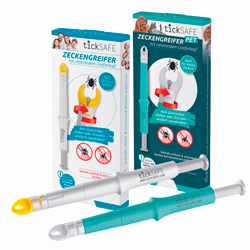Many types of tick removal aids are already being offered. Why a new type?
In the past it was said, that a tick must be removed as quickly as possible, no matter how. Today we are more cautious. As quickly as possible? Yes, but please as cautious as possible too. Using the patented principle of the soft rotating gripper head the Tickgripper offers a method that is cognizant of these new insights regarding the careful removal of ticks.
What's so bad about squeezing a tick?
Squeezing ticks increases the risk of infection. The risk of infectious transmission when using customary removal tools such as tweezers, forceps and other rigid devices, even a fingernail, is increased if the upper intestinal segments or salivary glands of the tick are squeezed.
Should I remove the tick immediately?
Yes! Since the danger of infection grows the longer the tick feeds on your blood, we recommend removing the tick as quickly as possible.
The tick was not removed in my first removal attempt. What should I do?
It is normal that repeated removal attempts may be required with the tickSAFE Tickgripper, especially for very small ticks.
How can I prevent ticks from getting into the Tickgripper?
Only very small ticks can escape into the inside of the Tickgripper. To avoid that, dab the tick on an adhesive strip immediately after having removed it and stick the tick on a submission form or a piece of paper. Make a note of when and where the tick has bitten. Later you can send in the tick if the situation requires it.
Can I use the same Tickgripper for both humans and animals?
For hygienic reasons it is recommended that separate devices are used for humans and animals.
What is the life expectancy of the Tickgripper?
Determined by the material the elastic force of the soft gripper decreases, especially if the Tickgripper is exposed to intensive insolation. Due to usage and storing this might happen sooner or later. An exact date of expiry cannot be determined.
Is the blood of a burst tick infectious?
Insofar the blood contains pathogens: Yes. However, sole contact with the skin does not transmit the pathogen.
Should one also send in animal ticks for testing?
As animals generally have greater contact with ticks it is more than likely that they will test positive for pathogens. Thus medical testing of animal ticks only makes sense if a serious tick disease is suspected.
Can one determine whether a tick is infections based on its size? ?
No, even nymph-stage ticks, so-called 'baby ticks', can be infectious.
How do I dispose of a tick?
It is very important that ticks be disposed of in an appropriate fashion in order to assure that they do not re-bite a new host.







